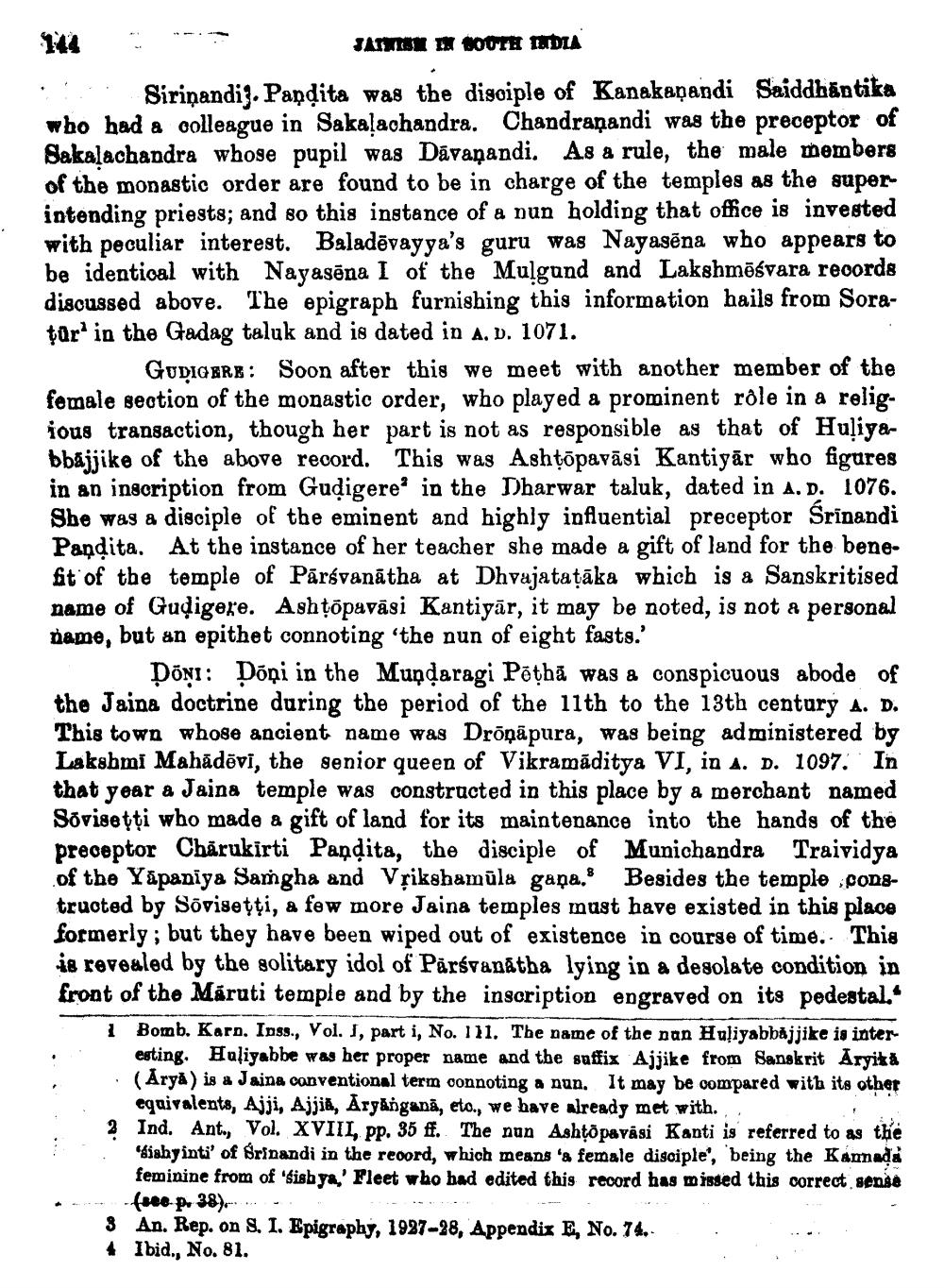________________
144
JATWISH IN SOUTH INDIA
Sirinandi. Pandita was the disciple of Kanakapandi Saiddhantika who had a colleague in Sakalachandra. Chandranandi was the preceptor of Sakalachandra whose pupil was Dāvanandi. As a rule, the male members of the monastic order are found to be in charge of the temples as the superintending priests; and so this instance of a nun holding that office is invested with peculiar interest. Baladevayya's guru was Nayasena who appears to be identical with Nayasena I of the Mulgund and Lakshmesvara records discussed above. The epigraph furnishing this information hails from Soratür' in the Gadag taluk and is dated in A. D. 1071.
GUDIGERE: Soon after this we meet with another member of the female section of the monastic order, who played a prominent rôle in a religious transaction, though her part is not as responsible as that of Huliyabbajjike of the above record. This was Ashṭōpavāsi Kantiyār who figures in an inscription from Gudigere in the Dharwar taluk, dated in A. D. 1076. She was a disciple of the eminent and highly influential preceptor Śrīnandi Pandita. At the instance of her teacher she made a gift of land for the benefit of the temple of Parsvanatha at Dhvajataṭāka which is a Sanskritised name of Gudigere. Ashṭōpavasi Kantiyār, it may be noted, is not a personal name, but an epithet connoting 'the nun of eight fasts.'
DONI: Dōni in the Mundaragi Petha was a conspicuous abode of the Jaina doctrine during the period of the 11th to the 13th century a. d. This town whose ancient name was Drōpapura, was being administered by Lakshmi Mahādēvi, the senior queen of Vikramaditya VI, in A. D. 1097. In that year a Jaina temple was constructed in this place by a merchant named Sōviseţți who made a gift of land for its maintenance into the hands of the preceptor Charukirti Pandita, the disciple of Munichandra Traividya of the Yapaniya Samgha and Vrikshamūla gana. Besides the temple constructed by Sōvisetți, a few more Jaina temples must have existed in this place formerly; but they have been wiped out of existence in course of time. This is revealed by the solitary idol of Parsvanatha lying in a desolate condition in front of the Maruti temple and by the inscription engraved on its pedestal."
1 Bomb. Karn. Inss., Vol. I, part i, No. 111. The name of the nan Huliyabbajjike is interesting. Huliyabbe was her proper name and the suffix Ajjike from Sanskrit Aryikä (Arya) is a Jaina conventional term connoting a nun. It may be compared with its other equivalents, Ajji, Ajjia, Aryangana, etc., we have already met with..
2 Ind. Ant., Vol. XVIII, pp. 35 ff. The nun Ashṭopaväsi Kanti is referred to as the "fishyinti' of Srinandi in the record, which means 'a female disciple', being the Kannada feminine from of 'sishya,' Fleet who had edited this record has missed this correct sense (see p. 38).......
3 An. Rep. on S. 1. Epigraphy, 1927-28, Appendix E, No. 74.4 Ibid., No. 81.
-




